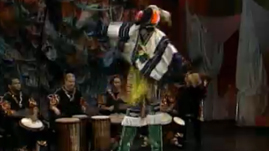Teachers' Domain - Digital Media for the Classroom and Professional Development
User: Preview



Moha Dosso, a professional stilt dancer and musician from the Mahouka tribe in Cote D’Ivoire, West Africa, performs the Gue Pelou dance from the Ivory Coast.
The Gue Pelou is a sacred rite used to honor and communicate with the spirit world and can be danced to protect the village.
Find additional arts resources for your classroom at the KET Arts Toolkit website.
Moha Dosso was born in Côte d’Ivoire. He is a drummer, singer, and choreographer who has performed with and coached several dance troupes in Ivory Coast. He is also a tailor, specializing in costume design. He is one of a very few acrobat stilt walkers and fire dancers performing in the United States. He shares this about the dances of the Côte d’Ivoire:
“Among the Mahouka people, Gue Pelou—the stilt dance—is used for ceremonies and rituals (like a wedding, funeral, or the arrival of the President or an important minister) and also for celebrations like a school dance. This mask represents a spirit who is blessing or protecting the village, so people are happy to see it. There are many other masked dances in Ivory Coast, too—using masks made of different materials and different movements. Women dance in certain masks, and men dance in certain ones.
“A long time ago, women discovered the stilt dance, and its purpose was purely ceremonial. The women went fishing one day, and it appeared to them. They brought it back to the village, and the men were very curious about what was inside the mask. When they tried to look inside, they found nothing—it was completely empty, and the mask’s clothes just fell to the ground. It was a very secret, very spiritual type of mask…
“Now, each village among the Dan people has a long mask or stilt dancer, and the mask has a name.... From my mother’s village, we have Gue Pelou. Stilt dance is really popular at home, partly because you can see the dancer coming from far away, and they can do acrobatics and really surprise people! But it really brings a blessing for the community.
“To learn this sort of information, you have to be initiated as a stilt dancer—it’s really only for the Mahouka and Yacouba peoples. Initiation is only possible if stilt-dancing is done in your mother’s, father’s, or grandfather’s family. Sometimes you can marry into a family and if you really like the mask, you might be able to be initiated. The identity of the mask dancer is kept secret, and the costume covers everything—heads, hands, feet. In my country, if a mask dancer gets a tear in his costume, the people nearby will rush to cover it and escort the mask away—it’s that important because of the role of the mask in my society, and people know how to protect it.”
Dosso says there are only three dancers from the Mahouka people in the U.S. right now—his uncle Vado Diomande in New York; his cousin Sogbety Diomande in Mansfield, Ohio; and Dosso, who lives in Cincinnati.
 Loading Standards
Loading Standards